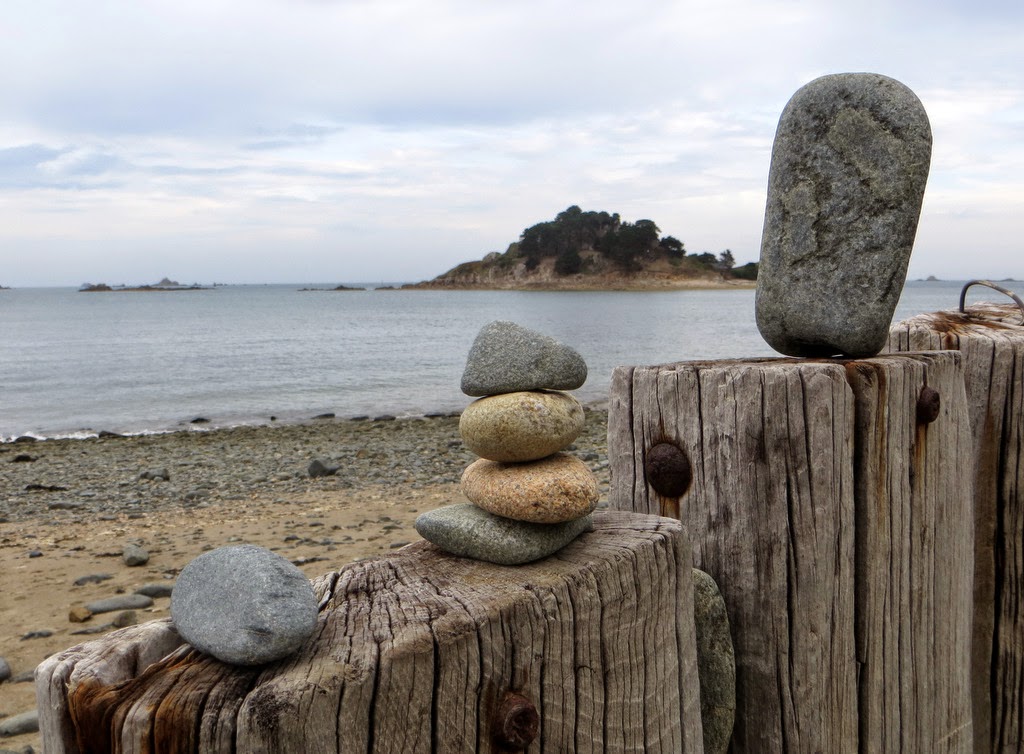The Bay of Morlaix from where we stay with its many rocks and islands and changing tones always reminds me of something Heather Dohollau said in a poem about seeing the Bréhat archipelago for the first time, that it was 'like a Leonardo or a Patinir', so that I half-expect to see a wonderfully out-of scale St Christopher half a mile high and confounding all perspective, striding across the water towards us.
We set off from the door at Kerbiriou, and for the first time walked around the entire edge of the small peninsular, skirting round the cairn of Barnenez, which is its main claim to fame. We did once pay admission and visit the cairn, but I'm afraid that, as with many prehistoric sites and monuments, it doesn't do a great deal for me. I have difficulty connecting, perhaps the imagination required to fill in the gaps is beyond me, but also the amount of artifice and making it up of those charged with preserving them sometimes seems unconvincing. Tom, who's done a bit of archaeology, grumbles rather about the French tendency to rebuild and reconstruct, but in fact in many later sites, such as mediaeval castles, I quite enjoy this, though I appreciate it might not always be quite authentic, and deny one the pleasure of ruins.
So anyway, this time we didn't go to the cairn, but followed the coastal path. At the top of the peninsular is the island of Sterec, about which I can find nothing on the web in English or French but images, which rather reflects how delightfully unknown and unfêted this whole small corner beyond the cairn is. It's one of those part-time islands, like the Île de Callot, which you can walk to at low tide, but I'm not sure what's there when you get there, and anyway on this occasion we couldn't.
I don't really know what this line of posts was for, or how long it had been there, or anything about it. Our hosts might have known, but I didn't think to ask them.
If its function was to hold back land fall, it seemed to have been replaced by this cage of pebbles. This kind of structure we've observed on a much grander scale filled with large grade aggregate holding up road building in quite precipitous places. I've wondered if the metal will ever corrode, bringing down concrete, bypass and all, but decided it's not my problem.
They probably aren't all that old, but sea and weather had done their work and they seem quite ancient and mysterious, full of potential but ungraspable meaning, like a woodhenge or processional alignment,
Unknown walkers and pilgrims had left their mark on them, in the form of those ubiquitous balanced stone towers
solitary mini-menhirs,
and precisely chosen pebbles placed in and across the gaps between them.
They were studded and pierced and infibulated with metalwork,
tattooed by rust with shamanic faces,
Even more pictures on a web album here.
































12 comments:
I like the way you make me see things for a second time but with
words attached that make me look a third and fourth time.
It's the first time that I think that some of the symbols presented, in general, are nothing but scratches.
I must add that you kept me longer going from link to link to link than you kept Tom looking for St Christopher.
Immediately saw the faces in the wood. Love the stacked rocks, of course.
Oh, oh, weathered wood (great name: woodhenge!), rust and rocks, by the sea too! My heart beats faster. Grand photos, Lucy!
"infibulated with metalwork"
Love this description in particular, and the way you make the wood posts seem prehistoric with faces of spirits and fossilized worms in them.
I always enjoy your posts first by just looking at the photos and seeing what story they tell or suggest, then by reading your wonderful observations of them.
Brilliant!
You have such a great eye, Lucy. And a husband with great patience.
I suffer from solar keritonitis and am now condemned to smearing my face with a lightweight grade of axle grease, thus reducing my social acceptability - always veatigial - to zero. The texture of those posts, so widely abused by natural forces, seems almost like a posthumous tribute to my complexion and I am taking what comfort I can from this possibly unintended gesture of yours.
How absolutely wonderful to find those posts and to make such a brilliant visual record of them, Lucy. More beautiful than most stuff that is called 'installations' in prestigious temples of art.
wow, your eye is a thing to marvel at, dear lucy!
my dad is obsessed with those little stone towers (in our part of the world they are called inukshuks) and any trip or hike or walk with him is always punctuated by moments where he disappears or lingers just to add to an existing tribe of inukshuks, or to build the very first. i didn't think much of it, but now realise that once he's gone (and hopefully not for a long time yet), that will always serve as a reminder of him.
The confluence of old wood, rust and spontaneous sculpture makes for mystery and your composition makes for a set of great photos. I also liked the long distance ones on the web page, the mount rising from the sea.
I once saw a programme about a wood henge that was unearthed or uplifted from the waves, and shown preserved perfectly by its long stay under the sand. But apparently after thousands of years it would disintegrate quickly once exposed to the air. I wonder....
As always, you find beauty and meaning in unlikely places! These pebble and wood images are inspirational, Lucy. x
Different people leaving their marks - intriguing!
Post a Comment